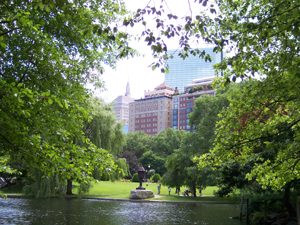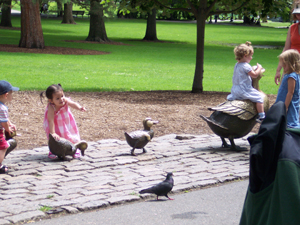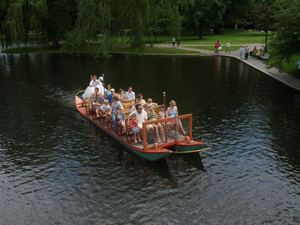Sometimes just getting into a city is exciting. We drove to the Alewife Station to board the
MBTA train for downtown Boston, but by mid-morning the parking garage at the Alewife Station
was full ... but not really, really full. What this meant was that the parking attendants
were using the extra space along the ramps and curbs to squeeze in some more cars. We
directed our full-size pickup down a long curving ramp, where we parked as close to the wall
as we could.
 Boston Garden
The only way we could get our truck out of this predicament would be by squeezing
past the other cars (some not parked nearly so close to the curb) and spiralling up and up
the ramp to the regular parking floor. Well, we would worry about that problem later.
Boston Garden
The only way we could get our truck out of this predicament would be by squeezing
past the other cars (some not parked nearly so close to the curb) and spiralling up and up
the ramp to the regular parking floor. Well, we would worry about that problem later.
We arrived at Boston Common just as the cloudy skies began to clear. The Massachusetts
State House (why is it called the State House, when Massachusetts is a Commonwealth?) was
our first destination.
 State House interior
Our friend Nancy had been a legislative aide here some years back,
and was happy to see her old haunts as we took the guided tour. The public rooms are graced
by statues of famous Americans -- and some only famous in Massachusetts, such as John Albion
Andrew (1818-1867), the so-called "War Governor." Originally a small building, the 1798 State
House was enlarged at the end of the nineteenth century. In the old section, some original
columns still stand, although encased in plaster to help preserve them. These columns were
made from pine trees from Maine, which was still part of Massachusetts at the time.
State House interior
Our friend Nancy had been a legislative aide here some years back,
and was happy to see her old haunts as we took the guided tour. The public rooms are graced
by statues of famous Americans -- and some only famous in Massachusetts, such as John Albion
Andrew (1818-1867), the so-called "War Governor." Originally a small building, the 1798 State
House was enlarged at the end of the nineteenth century. In the old section, some original
columns still stand, although encased in plaster to help preserve them. These columns were
made from pine trees from Maine, which was still part of Massachusetts at the time.
With the exception of a large bronze honoring Civil War nurses, all of the State House
memorials were for men until 1999.
 The new women's history panel
The State House recently added a memorial display honoring
famous Massachusetts Women leaders Dorothea Dix, Lucy Stone, Sarah Parker Remond, Josephine
St. Pierre Ruffin, Mary Kenney O'Sullivan, and Florence Luscomb.
The new women's history panel
The State House recently added a memorial display honoring
famous Massachusetts Women leaders Dorothea Dix, Lucy Stone, Sarah Parker Remond, Josephine
St. Pierre Ruffin, Mary Kenney O'Sullivan, and Florence Luscomb.
The original seal of the royal colony uses the spelling Mattachusetts. Our tour guide was as
baffled as we were, but using Google we learned that it was an alternative spelling
of the name, dating back to the original charter of 1629.
The General Court (the name goes back to colonial times) of The Commonwealth of Massachusetts
has two houses with virtually identical functions. Half the bills are given to each house.
Both Senators and Representatives are elected every two years, and although both houses are
overwhelmingly Democratic, the Governor and Lieutenant Governor are Republican.
Our tour guide took us into the visitors gallery of the House of Representatives, but instead
of listening to a debate we observed part of a ceremony honoring Corrections Officers.
A group award was given
 Brick-lined mews, Back Bay
to those members of the Middlesex County Sheriff's Department who
volunteered to assist New Orleans officers in the aftermath of Hurricane Katrina. In the
middle of the chamber hangs the Sacred Cod, without which the House cannot meet --- as was
indeed the case in 1933, when some Harvard students spirited it away for a week.
Brick-lined mews, Back Bay
to those members of the Middlesex County Sheriff's Department who
volunteered to assist New Orleans officers in the aftermath of Hurricane Katrina. In the
middle of the chamber hangs the Sacred Cod, without which the House cannot meet --- as was
indeed the case in 1933, when some Harvard students spirited it away for a week.
Emerging from the State House, we walked past the lovely old brick stores and houses in
Back Bay. We might have been in London as we negotiated brick sidewalks rippled by tree roots,
and admired the tidy park in Louisburg Square. Buildings either crowded to the edge of the
sidewalk or were set behind sidewalk-hugging iron fences with tiny front yard gardens.
Although many houses have historic plaques, John Kerry's house is not marked. One of
Massachusetts'
 Make Way For Ducklings more famous architects was Charles Bullfinch, who designed not only public
buildings but homes as well. Two examples sit side by side on Beacon Hill.
Make Way For Ducklings more famous architects was Charles Bullfinch, who designed not only public
buildings but homes as well. Two examples sit side by side on Beacon Hill.
After a tasty lunch at a Thai restaurant on Charles Street, we peeked into Savenor's,
where Julia Child bought meat and provisions, admiring the variety of meats and delicacies,
including kangaroo sausage.
From the Charles River next to Storrow Drive it was but a few blocks to the Boston Garden,
where we watched children playing with the bronze ducks, which in turn were placed in
tribute to Robert McCloskey's famous children's book, Make Way For Ducklings.
The Garden is the first public botanical garden in the United States. Spacious and
welcoming, it was filled this day with visitors of all ages, and sparkled with dozens of
colorful flower beds.
 A swanboat in Boston Garden
The recent rains have produced grass and leaves of brilliant
shades of green -- the old weeping willows seemed particularly lush. We watched several
passages of swan boats. These dignified launches are powered by the strong legs of the
young drivers. Probably no one knows how many statues of George Washington exist in
Boston alone, but the dramatic sculpture of the general on horseback is especially attractive.
A swanboat in Boston Garden
The recent rains have produced grass and leaves of brilliant
shades of green -- the old weeping willows seemed particularly lush. We watched several
passages of swan boats. These dignified launches are powered by the strong legs of the
young drivers. Probably no one knows how many statues of George Washington exist in
Boston alone, but the dramatic sculpture of the general on horseback is especially attractive.
Commonwealth Avenue is a broad divided boulevard, split by a wide park filled with statues.
Fresh out of Oberlin College, Nancy had lived on Commonwealth Avenue while she held her
first teaching job.
 Fire fighters lost in 1972 Fire
At that time some of the residences on Commonwealth Avenue were still
occupied by single families; now they are nearly all divided into blocks of apartments.
Fire fighters lost in 1972 Fire
At that time some of the residences on Commonwealth Avenue were still
occupied by single families; now they are nearly all divided into blocks of apartments.
The statue of Samuel Eliot Morison, sitting astride a rock holding binoculars, is an
excellent work of art, but the eminent Harvard professor and naval historian has been well
tarnished for his racial bigotry. The memorial to the 16 Boston firefighters who died in
the 1972 Hotel Vendome fire is beautifully done.
We cut across Newbury Street to Copley Square, where we admired the beautiful architecture
of Trinity Church before plunging into the Boston Public Library. The library comes in two
sections, one old with marble and polished wood and enormous lions, the other spare and
geometric (and full of books), but we spent most of our time admiring the art in the old section.
One of the featured displays was the enormous collection of Joan of Arc statues, medallions,
cameos, books, ceramics, prayer cards, tobacco cards, chess pieces and ephemera. It was
donated to the Library in 1976 by Cardinal Wright, who had served in his youth as a stack
boy (shelver) at the library. Oddly, all of the graphic representations of Joan of Arc are as
imagined by artists -- there is no known picture of the Maid of Orleans drawn from life.
We admired the long reading room with comfortable large tables and reading lamps, and
tagged along to hear the tail end of a guided tour describing the John Singer Sargent murals
painted between 1895 and 1916. Apart from the controversial aspects of having a public
building contain overtly religious art, a curious aspect is the three-dimensional touches
 One of the Sargent murals
that Sargent, rather daringly for his time, added. There are rays of sunlight and other
"golden" ornaments made of papier-mache, for example.
One of the Sargent murals
that Sargent, rather daringly for his time, added. There are rays of sunlight and other
"golden" ornaments made of papier-mache, for example.
We hadn't walked as far as we did when we tired out our teenage grandson in Paris, but our
legs felt grateful when we finally sat down on the train ride back. There was a chain
blocking off the entrance to the spiral ramp where our truck was parked, but we persevered
and managed to hit no other vehicle as we exited the garage.
We've taken three or four long walks in Boston over the last two years, and the city
continues to reward our efforts.
 Boston Garden
The only way we could get our truck out of this predicament would be by squeezing
past the other cars (some not parked nearly so close to the curb) and spiralling up and up
the ramp to the regular parking floor. Well, we would worry about that problem later.
Boston Garden
The only way we could get our truck out of this predicament would be by squeezing
past the other cars (some not parked nearly so close to the curb) and spiralling up and up
the ramp to the regular parking floor. Well, we would worry about that problem later.
 State House interior
State House interior  The new women's history panel
The new women's history panel Brick-lined mews, Back Bay
Brick-lined mews, Back Bay Make Way For Ducklings
Make Way For Ducklings A swanboat in Boston Garden
A swanboat in Boston Garden Fire fighters lost in 1972 Fire
Fire fighters lost in 1972 Fire One of the Sargent murals
One of the Sargent murals